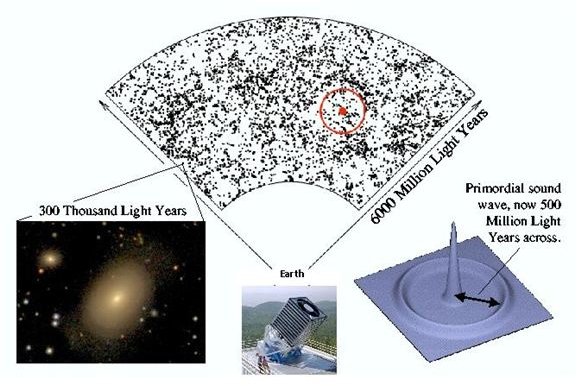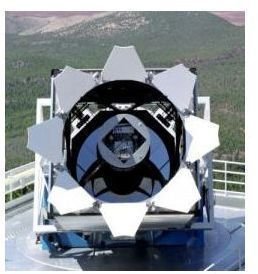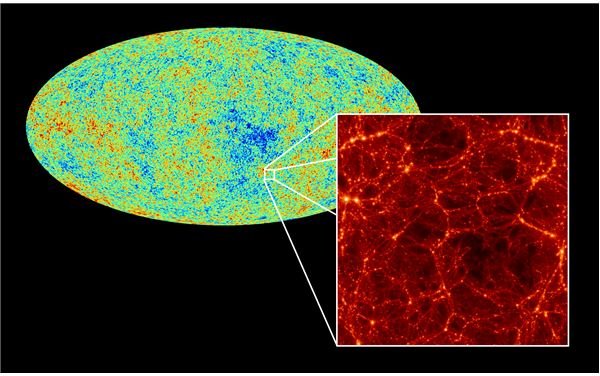Baryonic Acoustic Oscillations May Measure Universe's Expansion Rate
How fast is the Universe expanding and how do you measure that rate?
These two questions are behind the physics of the Baryon Oscillation Spectroscopic Survey (BOSS). This survey started in 2009 and ends in 2014, and maps the universe. It will also answer the question ‘what causes the expansion to occur? The belief now is that dark energy is behind the expansion.
There is more to learn about dark energy, which is available at Dark Matter & Dark Energy, Are They the Same?
What are Baryon Acoustic Oscillations?
A Baryon is ordinary matter, that is protons, neutrons and other massive but unstable heavier particles called hyperons. At the time of the Big Bang, and for about 400,000 years afterwards, the density of the universe kept photons and Baryons interlocked or entangled together. Only as the universe cooled and expanded did the decoupling take place. Photons were now able to travel largely unimpeded and the speed of sound caused by the decoupling fell as matter began to take shape from separate atoms into clusters of atoms.
The Dark Energy Problem
The expansion rate of the Universe is increasing, not slowing down. How is that possible? One of the theories in place now involves studying the different densities left over from different times. This evidence will provide information about how the expansion of the universe occurred and how the density varied at different times. At an early time of the universe, the density was very high, so the expansion was not great. However, as the energy and matter density decreased, the universe began to expand faster. As the density across the universe decreases, the gravitational effect also gets weaker, so expansion gets faster.
Think of a rocket trying to get into space. The closer the rocket is to the earth, the denser the matter, so it takes a lot of energy to move the rocket into space. But once in space the gravity drops considerably, and the rocket can go faster, and its rate of travel can increase.
Scientists now believe that acoustic oscillations will provide the evidence for the expansion. Earlier periods of the universe should be denser than later periods. In other words, by measuring the length of the baryonic acoustic oscillations, scientists believe that with this information astronomers will be able to determine how dark energy has affected the expansion. They will have proof that the expansion rate changed over time. It was slower at the beginning, and faster now.
Initially it happened in the following manner. An overdense region of the primordial plasma existed.This overdensity attracts matter towards it through gravitational forces. However, the heat of photon-matter interactions does the opposite; it creates a large amount of outward pressure. It is the counteracting forces of gravity and pressure that create the oscillations, it is similar to how sound waves are created in the air by pressure differences.
About the Image: Anisotropies relates directly to variations in the density of galaxies as observed today. This is the property of being different, not the same in all directions in the cosmic microwave background, which originated when the universe was less than 400,000 years old.
You can read more about Dark Energy at Expanding Universe and the Mysterious Force of Dark Energy.
Image Credit: Berkley Lab News Center
The Acoustic Ripple
Astronomers began to consider motion at the earliest time of the universe. Sound waves passing through the air will push matter closer as they travel. The early universe was turbulent but sound waves propagated across matter like spreading ripples in a pond, leaving an imprint on cosmic microwave background fluctuations. These fluctuations have modified and evolved into today’s galaxies and spacial voids between galaxies. It is this baryon acoustic oscillation scale that is visible among galaxies today. It is at the heart of this scientific investigation. In the time frame of the early universe sound waves were moving at half the speed of light, but when the cooling began after several hundred thousand years, the waves halted, but a signature remained of the their travel. This is a 500 million light-year indicator.
The Universal Ruler
In order to take any kind of measurement, especially one involving distant galaxies and stars, one must be confident that the measurement device can be accurate so that the discovered results that are sound. In this regard, the Lawrence Livermore National Laboratory, along with the 2.5 meter Sloan Digital Sky Survey telescope at Apache point in New Mexico, are working together to map the universe and determine how the expansion occurs.
The task to study dark energy began in 2006 when measurements from 46,000 luminous red galaxies across 6.5 billion light years of space occurred. The finding then was that there was an excess of galaxies 500 million-light-years apart. This means that as a measuring rod, by measuring the size of the galactic distance at different times, one can study how the expansion of the universe changed.

About the image: A Sloan Digital Sky Survey map shows that there is a pattern in the distribution of galaxies, indicated by the red bullseye. Observations of this pattern at different times in the history of the universe will help explain how the expansion of the universe has changed, which will place limits on the nature of dark energy.
Image Credit:Sloan Digital Sky Survey
What will BOSS Study?
This new study will look at 1.5 million galaxies over a large area of space. It will use the redshift marker, which shows that an object is moving away from the source of the observation. This occurs by measuring the wavelength of the light. When light shifts to a lower and redder frequency this shows that, the object is moving away.
- The BOSS will study the expansion using a redshift indicator up to 0.7, which is near the time when the universe was about 7 billion years old.
- It will also study 160,000 quasars with a redshift between 2 and 3, or when the universe was only about 3 billion years old.
- It will also measure the density of hydrogen gas between the galaxies.
- This five-year study will look at the universe at three different times over a time of 10 billion years.

Credit: Sloan Digital Sky Survey, Astrophysical Research Consortium
You can read about other types of telescopes at Radio Telescopes – Invisible Signal Detectors.
Sources
University of Arizona, Detection of the Baryon Acoustic Peak in the Large-Scale Correlation Function of SDSS Luminous Red Galaxies
This post is part of the series: Modern Telescopes on Earth and in Space
In this series of articles we look at the changes in telescope design and what information they provide about astronomical objects.
